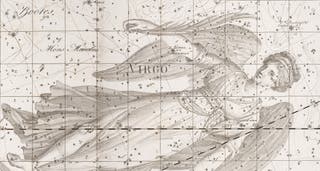Rubie, G. The British celestial atlas. London, 1830.
This was a non-professional atlas, written by an educator for students. But it utilizes a feature that would become increasingly popular among amateur astronomers, the monthly star chart. Actually, Johann Bode was the first to publish a series of maps showing how the night sky changes month by month; they appeared in his astronomy textbook of 1768, which went through many later editions. But few other astronomers picked up on the idea until Rubie.
The advantage of the monthly chart is that is shows you very clearly which constellations you will see in the late evening if you look to the south. In the case of the chart opposite, for February, you will see Taurus, then Orion, and the Gemini pass over the meridian.
The detail below, from the June chart, was chosen because it corresponds wit the images of Bootes and Ophiuchus that we have seen in the atlases of Pardies, Wollaston, and Burritt (items 17-18, 37, 39). Note that the Rubie chart is actually fairly easy to use, even without the constellations, because only the principal stars are shown. So it is easy to pick out the three belt stars of Orion (above), or Arcturus in Bootes and Antares in Scorpio (below).

